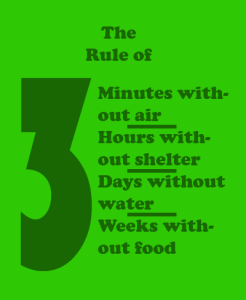Knowing the rule of 3s, focuses you on your survival priorities. It’s funny in many Hollywood dramas about survival situations, how the characters spend a considerable amount of time and energy pursuing the wrong priorities, and could very well in real life result in their doom.
3 Minutes Without Air; going without air is known as Hypoxia. Hypoxia can be generalized, affecting the whole body or it can be localized to a portion of the body. It can be caused generally in healthy people by being at a high altitude or breathing gasses low in oxygen content. High altitude typically over 8200 ft or 2500 m can cause High Altitude Pulmonary Edema (HAPE), a life threatening condition resulting in the lungs accumulating fluid. This condition requires immediate medical attention and getting the subject to low altitude.
3 Hours Without Shelter; being without shelter in harsh weather will kill you! The inability to protect the body from cold can result in hypothermia, a condition that occurs when the body’s core temperature drops below 95 degrees. Alternately, hyperthermia is the opposite. When the body takes on more heat than it can dissipate, commonly caused by heat stroke due to prolonged exposure to high heat and/or humidity.

Therefore, in a survival situation establishing shelter should be your first priority! The type of shelter depends on the circumstances. If you’re lost and want to be found, seeking shelter in a manmade structure or high visibility location, using signal fires for warmth/cooking and signaling is the route you want to take. However in an SHTF situation where you are either on the run evading capture or avoiding human contact trying to get to your bugout location and need temporary shelter. Use the SERE acronym BLISS:
Blend in
Low Silhouette
Irregular Shape
Size
Secluded Location
Blend in: use low visibility material and camouflage your shelter with cuttings from the local vegetation. Construct it in a shadowy/low lying area (not a dry wash if rain is likely) away from roads and trails. Humans are basically lazy and won’t go into hard to access places without good reason.
Low Silhouette: keep your shelter low to the ground, waist high or below, preferably knee high. Avoid high ground, stay in or near the bottom of hills/draws/hollows. If you are halfway up a hill but low to the ground, you are still head height to someone standing below you.
Irregular Shape: regular geometric shapes are very noticeable to the human eye and indicate a manmade structure. Be mindful not only of how your shelter looks close up but also from a distance and from above. Looking down on a square tarp from a hilltop or from the air would be a dead giveaway!
Size: make a shelter just big enough to do the job, keep it small! If you’re with your family, consider making multiple small shelters instead of a single large one. This is to protect you from the elements while you rest or lay low during high enemy activity not a place to sit around and play cards, so big enough for one or two people to lay down and rest.
Secluded Location: stay away from buildings, roads and trails. Avoid clearings and high ground, in times of bright sun light, avoid casting shadows when possible.

3 Days Without Water; while it is true there are cases of people living without water for a week, this is NOT an area you want to experiment around with. Our bodies are 65% water and dehydration has serious physical consequences, some of its symptoms are: weakness, sluggishness, confusion, and fainting. When on the move trying to avoid detection, I definitely don’t want to feel sluggish, weak and confused… STAY HYDRATED! Water collection methods and sources will depend on your environment and will have a future article devoted to it. However for now, suffice it to say keep a personal water filter and chemical water purifying pills in your bugout bag. Boiling water is also an option, however should be avoided when on the move as fires will attract attention.
3 Weeks Without Food; although food is the least critical of our necessities, it is no less important. When we go without food our bodies go into starvation mode and begin to store fat and metabolize our muscle tissue. It can also result in physical weakness and dehydration. When at our shelter in place or our bugout locations, considerable time and resources can be devoted to the hunting and gathering of food, however if our transit time is less than a few days, hunting and cooking is not practical and the cooking fire could have a more detrimental effect than a few days without eating.
In short, if an SHTF situation should catch you traveling on foot in hostile or potentially hostile territory. If you’re having difficulty breathing due to altitude, all effort should be focused on getting to a lower altitude. If you can breath, shelter when the local population is active and travel when they are less active. Establish your shelter with consideration for the acronym BLISS, near a reliable water source. If you can get to your destination in a few days and a food source isn’t readily available, forgo it, however if the travel will be extended, attempt to find a food source that doesn’t require cooking.
